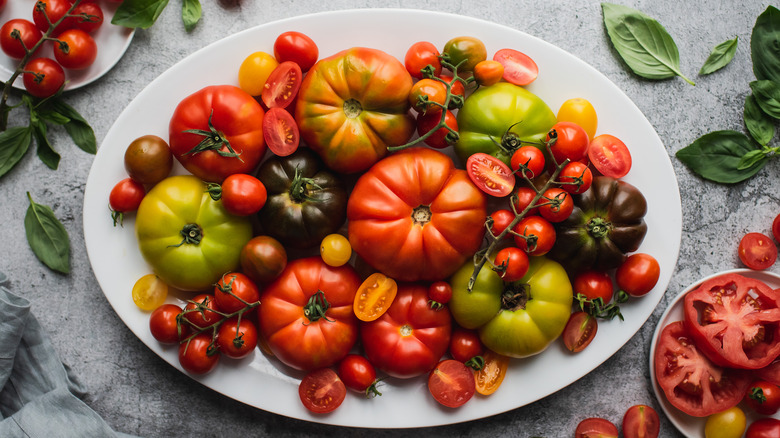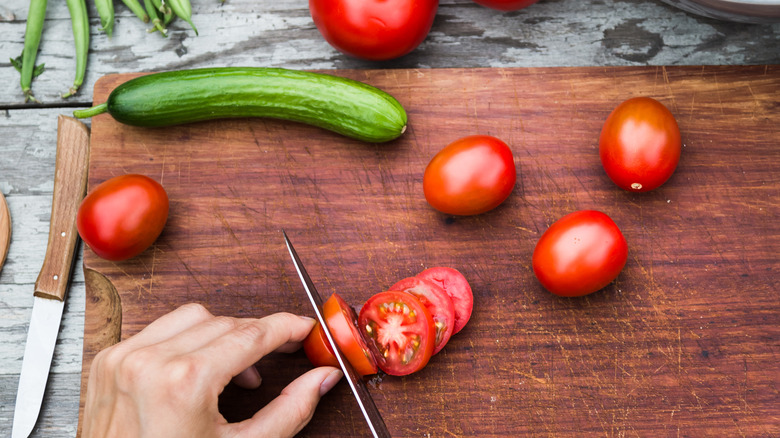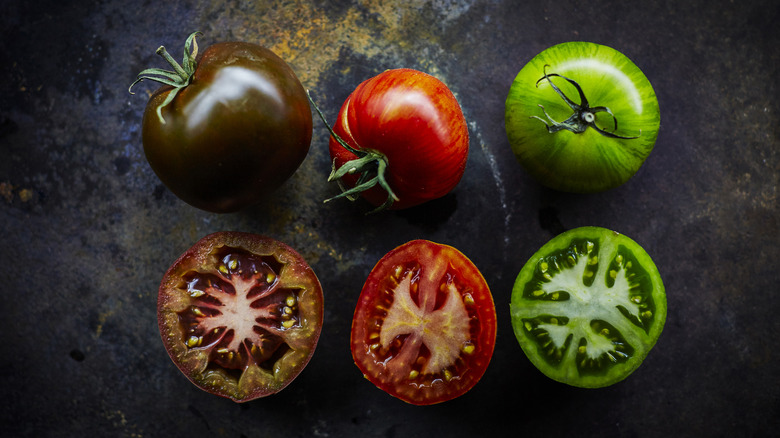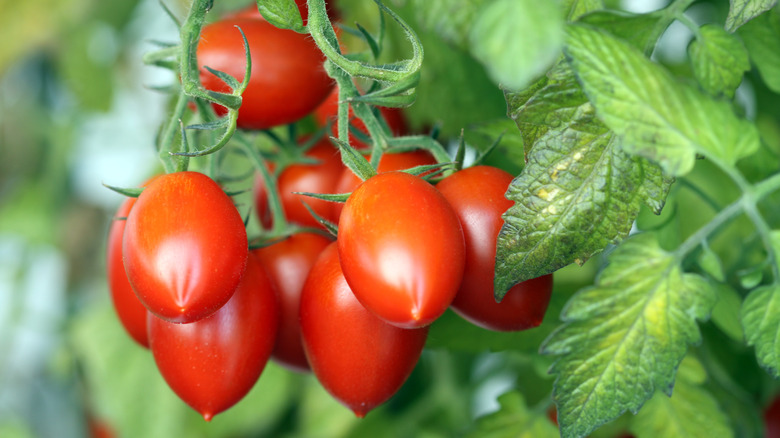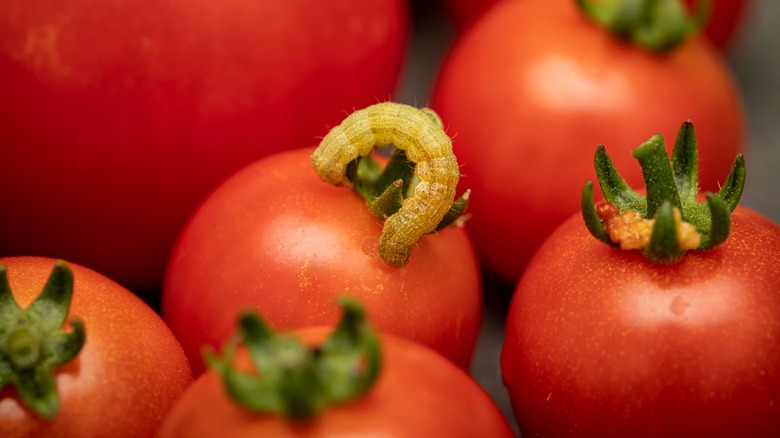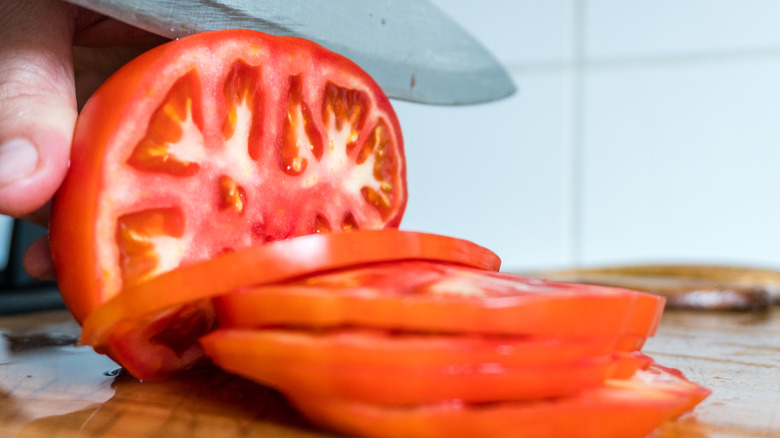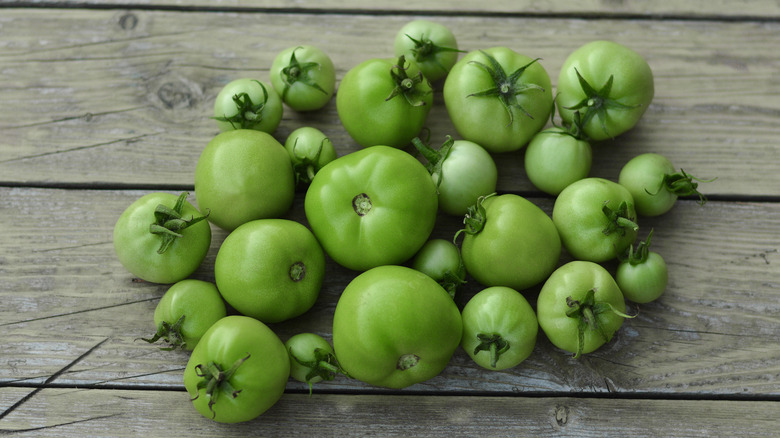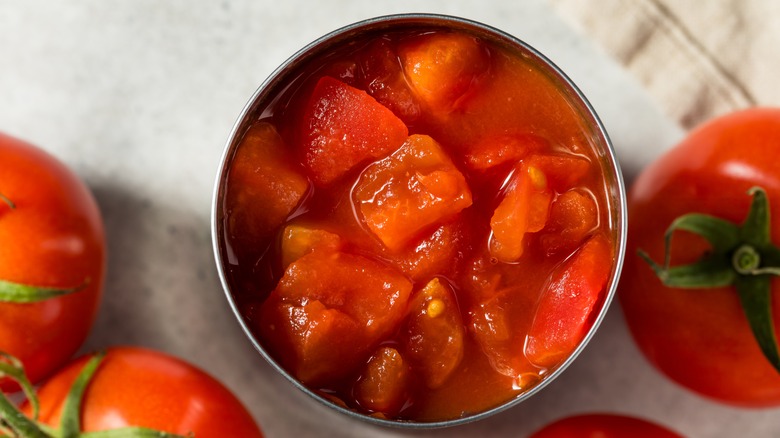12 False Facts About Tomatoes, Debunked
Though tomatoes are now ubiquitous in the culinary traditions of cultures across the globe, they have not always featured so prominently in the diets of human beings. In fact, this culinary staple, which was first cultivated by indigenous populations of ancient Mesoamerica before being exported to Europe in the 1500s, has had quite a storied history, punctuated by legend and folklore. From its link to witches and werewolves to its purported role in casting spells for protection, success, and love, this fruit has had a long and complicated road from ornamental plant to household food source.
From my perspective as a professional chef, I am less interested in the more obscure, magical beliefs that once vilified the tomato than I am with false facts that continue to persist surrounding its potential uses and health benefits. As one of my favorite ingredients in recipes from salads to soups to sauces, tomatoes have long captivated me for their versatility and capacity to be transformed with just a little know-how and creativity. For this reason, I wanted to debunk some of the more pervasive myths about tomatoes and illuminate the ways in which these have hindered them from realizing their full potential in the kitchens of many.
1. Myth: Tomatoes are a vegetable
Perhaps the most common myth circulating about tomatoes is that they are vegetables. When it comes to the ways in which chefs utilize tomatoes, they do, indeed, fit this classification. They are typically added to savory recipes, like soups and salads, alongside other vegetables, providing generous amounts of acidity and tartness that can help bring an element of brightness to a dish.
To complicate matters, tomatoes have also been classified as a vegetable by the U.S. Supreme Court. On May 10, 1893, in the case of Nix V. Hedden, it was determined that similarly to other fruits of a vine, including cucumbers, squashes, beans, and peas, tomatoes were predominantly utilized in recipes that compose the primary part of a meal rather than the dessert. For this reason, they could be considered a vegetable and were therefore subject to an importation tariff under the Tariff Act of March 3, 1883.
Regardless of culinary or legal classifications, botanically speaking, tomatoes are fruits, because they contain seeds. They are a member of the Solanaceae family of flowering plants, also known as nightshades, which includes potatoes, peppers, and eggplants. More specifically, tomatoes are berries, which are defined as plump fruits that emerge from a lone flower having just one ovary. All of the more than 7,000 different types of tomatoes that exist come from the species known as S. lycopersicum.
2. Myth: Tomatoes are always red
Based strictly on the color of most store-bought tomato soups, sauces, and salsas, you'd probably think that all tomatoes are red. While many of those grown for commercial consumption are, this has not historically been the case. Wild tomatoes, known as "pimps," were historically petite, quite tangy, and were often orange or yellow in hue. It was from these hardy plants that modern-day tomatoes were domesticated, selecting for larger sizes, sweeter flavors, and more visually appealing crimson flesh.
That said, if you take one look at the various varieties of tomatoes you can find at any farmer's market, you will quickly discover that the possibilities of shapes, sizes, and colors are vast within this species of fruit. Some, like the Cherokee Purple or the Black Krim, have colors that more closely resemble small eggplants, while others, like the heirloom Yellow Pear, have an almost canary yellow hue, more befitting of a pineapple or a lemon. Then there are varieties, like the Green Zebra, that are verdant in hue when ripe. These striated, hybrid varieties are best known for their firm flesh and sweet, yet tart flavor, which can enhance any recipe in flavor, texture, and visual appeal.
3. Myth: All tomatoes are rich in lycopene
One of the purported health benefits of consuming tomatoes is that they are a rich source of lycopene, an antioxidant often found in fruits and vegetables that are crimson in hue. This nutrient is well known for its myriad health-boosting properties, including the elimination of free radicals in the body, promoting a diverse gut microbiome, and improving cardiovascular well-being.
As noted, not all tomatoes are reddish in color. Since lycopene is generally found in the skins of this fruit, the brighter the crimson hue of the tomato, the more highly concentrated it is in this antioxidant. As a general rule, cherry and roma tomatoes boast the most abundant amounts of lycopene, though the yellowish Sungold is also a prolific producer of this nutrient.
Another factor in lycopene content is how the tomatoes are processed. Contrary to popular belief, while fresh fruits and vegetables are often considered to be higher in nutrients than those that are cooked, in the case of lycopene and tomatoes, this is not the case. When tomatoes are turned into a sauce or soup, the lycopene becomes more bioavailable, meaning it is easier for the body to absorb. Additionally, consuming tomatoes with some fat can quadruple the absorption rate of lycopene.
4. Myth: Tomatoes are poisonous
Another common myth about tomatoes that proliferated as they made their way across Europe during the 1700s, was that they were poisonous and therefore only suitable for growing as an ornamental plant, not an edible one. Dubbed "poison apples," tomatoes earned the reputation that they were toxic by well-to-do consumers who were developing mysterious ailments after eating them. What they failed to recognize was that the fruits themselves weren't the problem, it was the service ware upon which they were being prepared and consumed, which were made from pewter. As the acidic tomatoes interacted with the reactive pewter, lead was released, leading unsuspecting diners to die from lead poisoning.
In the Americas, things weren't much better for the tomato before the Civil War. At that time, tomatoes and tobacco plants were often inhabited by a type of hornworm that instilled fear among would-be tomato-eaters. It was believed that inadvertently consuming one of these, or even coming into contact with one, would prove deadly. For this reason, tomatoes were looked upon with suspicion. Fortunately, Americans soon recognized the tremendous canning potential of this fruit, and it became a common staple of the Southern diet.
5. Myth: Tomatoes do not pair well with fruit
There is a famous saying generally attributed to the British journalist and humorist Miles Kington that states: "Knowledge is knowing that a tomato is a fruit; wisdom is not putting it in a fruit salad." As a chef, I have often heard this statement quoted, which leans into the generally accepted differences between the botanical and culinary classifications of the tomato. It normalizes preconceptions about the tomato that seek to pigeonhole it into more savory applications.
Various fruits, from pineapples to strawberries, are often cited as ideal accompaniments to tomatoes. The key to marrying these seemingly disparate ingredients is understanding the core flavor and aromatic elements that make tomatoes distinctive. These can be exploited to help balance out and accentuate sweeter ingredients in a dish, developing a complexity that transcends knowledge and wisdom, by existing in the realm of art, which often defies convention by seeing things in unique ways that can be risky, yet rewarding.
It is important to highlight the inherent acidity of tomatoes and to use this to tame more saccharine fruits. The slightly earthy, grassy elements of some tomatoes can also contrast the tartness of many berries, rounding out those lip-puckering edges and giving them some nuance. I often include a creamy element, like fresh mozzarella or ricotta, that helps to join fruits and tomatoes together. The saltiness and luscious mouthfeel are the perfect intermediaries between the vegetal and the fruity components.
6. Myth: Tomatoes cannot be used in desserts
Expanding on the notion that tomatoes and fruits do not go together is the perception that they cannot be successfully incorporated into desserts. This is another misconception that is overly myopic. Some of my most surprisingly tasty dessert recipes include tomatoes. Again, the key is leaning into the distinct flavor and aromatic characteristics that make tomatoes so unique. These features help tomatoes to straddle the sweet and savory domains deftly and deliciously.
When it comes to cakes, quick breads, and other baked goods, tomatoes can easily be incorporated into a number of basic recipes in similar ways to other vegetables, like zucchini or carrots. Their high moisture content can keep baked goods tender, while their natural acidity can aid in leavening, producing impossibly fluffy results.
The one change I recommend is incorporating alternative sweeteners to plain white sugar. Brown sugars tend to have a more savory, caramel-forward flavor that can really play off of the earthiness of tomatoes, while various types of honey and maple syrup embody the terroir from the microclimate of the area in which they were sourced. These nuanced flavor components can really accentuate the juxtaposition between sweet and savory. Lastly, always select the ripest tomatoes possible for dessert recipes, particularly those where the tomato is the star, like sorbet or ice cream. This will ensure they are at their sweetest and most flavorful.
7. Myth: Tomatoes should be stored in the refrigerator
While many fresh fruits and vegetables should be stored in the refrigerator for safety and longevity, tomatoes are not one. Tomatoes are incredibly susceptible to chilling injury, a phenomenon that occurs when they are stored at temperatures between 32 and 59 degrees F. Chilling injury can result in tomatoes becoming mushy, mealy, and muted in flavor. For this reason it is important that fresh tomatoes are always stored on the countertop in the kitchen or pantry. Tomatoes should also be stored in a single layer, away from other ethylene producing fruits and vegetables, like bananas and apples. These can expedite the ripening and rotting process, resulting in the tomatoes spoiling more rapidly. Additionally, some experts believe that the optimal way to store tomatoes is stem side down. This can prevent moisture loss and help them maintain their firm texture.
The one exception to this rule are tomatoes on the verge of being overripe. If they are getting to the point where they either need to be used immediately or discarded, you can extend their shelf-life by a couple of days in the refrigerator. Though they aren't as delectable for consumption in a salad, they can be used in a sauce or soup. Additionally, once a tomato has been sliced, it is particularly vulnerable to pathogens, necessitating that it be transferred into an airtight container and refrigerated within four hours to prevent food borne illnesses.
8. Myth: All tomatoes can be used interchangeably in recipes
From a culinary perspective, this myth may be one of the most important takeaways for maximizing the potential of tomatoes in recipes. Chefs have a unique advantage over home cooks in many instances when it comes to knowing the minutiae of details that separate one specific variety of an ingredient from another. This is no less important where tomatoes are concerned. It may be tempting to assume that a tomato is a tomato is a tomato, regardless of what you are making, but the truth is, each variety of tomato has unique characteristics that make it more or less well-suited for a salad or salsa versus a soup or sauce. Capitalizing on these eccentricities is sure to elevate your tomato game and make your favorite tomato recipes taste infinitely better.
When it comes to raw applications, like salads or sandwiches, large tomatoes with high moisture content, like beefsteaks, are ideal. Their juiciness can shine as can their varied colors and shapes. The same qualities that make these tomatoes ideal for salads and sandwiches make them less desirable for cooking. Excessive moisture can require too much time to reduce a sauce or soup and concentrate flavors without risking scorching the tomatoes in the process. Other attributes that are favorable for cooking include thin skins and minimal seed content. For this reason some varieties, like plum tomatoes and the legendary San Marzano variety, are sought-after for sauces and soups.
9. Myth: How you slice a tomato doesn't matter
While it may seem like it shouldn't matter how you cut a tomato for maximum flavor and texture, there are some basics that can impact the final result of a dish, especially if you are leaving the tomatoes in slices or wedges. Before delving into the morphology of a tomato, it goes without saying that the tool you use to slice one is as important as any other factor. Though a sharp chef's knife can work, one with a serrated edge is more likely to be able to tackle tomatoes with thinner, more delicate skins. Some chefs, like Giada De Laurentiis, even rely on kitchen shears for cutting tomatoes into bite-sized pieces in sauces and soups.
As a tomato grows, it expands from the stem end of the fruit, developing a sturdy internal core surrounded by tender flesh that is encased by somewhat papery skin. This is important to recognize because the core acts as the de facto spine of the fruit, holding all of its components together. When slicing a tomato, it makes sense to cut against the core, retaining the structural integrity of the tomato and allowing for maximum flavor to be absorbed by every nook-and-cranny of the fruit. As Alex Guarnaschelli notes, this technique also makes it easier to remove the pulp of the tomato, leaving behind the meaty "tomato petals," which can be lovely when added to salads, sandwiches, and more.
10. Myth: The smaller the tomato, the sweeter it is
"Micro" and "Miniature" versions of fruits and vegetables are all the rage right now. While the old adage "good things come in small packages" may apply to miniature versions of many fruits and vegetables, smaller size doesn't always equate to more flavor. From greens to melons to carrots, these diminutive versions of their full-sized relatives are convenient for smaller spaces and can come with big textural and flavor advantages. However, the overall quality of the fruit has as much to do with the specific variety cultivated and the environment in which it has been grown as it does with the size of the produce.
When it comes to tomatoes, there is another criteria that is used to identify the sweetness of these fruits: the Brix Scale. Though this scale is better recognized for its utility when it comes to grapes being harvested for winemaking, it is often applied to tomatoes. The basic scale measures the amount of sugar present in the juice of a fruit. The higher the Brix ranking, the sweeter the fruit. Among the 10 highest-ranking tomatoes on the Brix scale, several are on the medium to larger size of the spectrum, including Brandywine Pink, Lucky Tiger, Mr. Stripey, and Pink Lady. This highlights the fact that everything from the amount of sunlight to the temperature to the quality of the soil can all contribute to the overall sweetness of a tomato.
11. Myth: Tomatoes cannot be eaten underripe
Anyone who has ever eaten a fried green tomato knows full well that an unripe tomato has its utility in the kitchen. That said, there is some concern that doing so can be potentially unhealthy or even toxic. While green tomatoes do contain alkaloid compounds, such as solanine, these are only toxic in large quantities. According to WebMD, an average person weighing 150 pounds would have to eat 136 milligrams of solanine to begin experiencing adverse effects. Some people prefer to consume green tomatoes, and want to preserve this texture and flavor for a number of different applications, ranging from pies and breads to preserves and pickles.
If you are one of those who grows tomatoes and are seeking to reserve a few for these more savory applications, this is the one time you get a hall pass to pop those verdant beauties in the refrigerator. There are a couple of caveats, however, to this storage method. First, make sure you do not wash the tomatoes before putting them in the refrigerator; you don't want them to get water-logged. You also only want to store tomatoes that lack any blemishes or bruises. Each tomato should be gently encased in a clean, dry paper towel and tucked into the crisper drawer of the refrigerator, which is designed to maintain a consistent humidity that will help to preserve the tomatoes in a kind of homeostasis for a longer period of time.
12. Myth: Fresh tomatoes are always better than canned ones
Some chefs have a deeply held belief that fresh produce is always superior to canned varieties. While this may be the case in some circumstances, it is not always the best option when it comes to tomatoes. Not only are canned tomatoes convenient and affordable, they can be more flavorful and have nutritional advantages over their freshly picked counterparts.
Tomatoes are canned at the height of freshness, sealing in their aroma and flavor and helping them retain their bright color. The very process of canning involves cooking the tomatoes, which may result in the loss of some water-soluble nutrients. However, as previously noted, this has been shown to be a nutritional advantage when it comes to lycopene content, improving its bioavailability, making canned tomatoes a better option for your next marinara sauce or bisque recipe.
If you are concerned about salt content or additives, look for varieties that are marked as "low-sodium" or "no salt added" and that do not reflect excess preservatives on the label. I also tend to favor fire-roasted canned tomatoes over plain ones. They have a more robust flavor and a richer texture. If you really want to maximize the flavor and texture of canned tomatoes, toss them on a baking sheet and roast them for a few minutes. This will eliminate excess moisture and help jumpstart the caramelization process.
